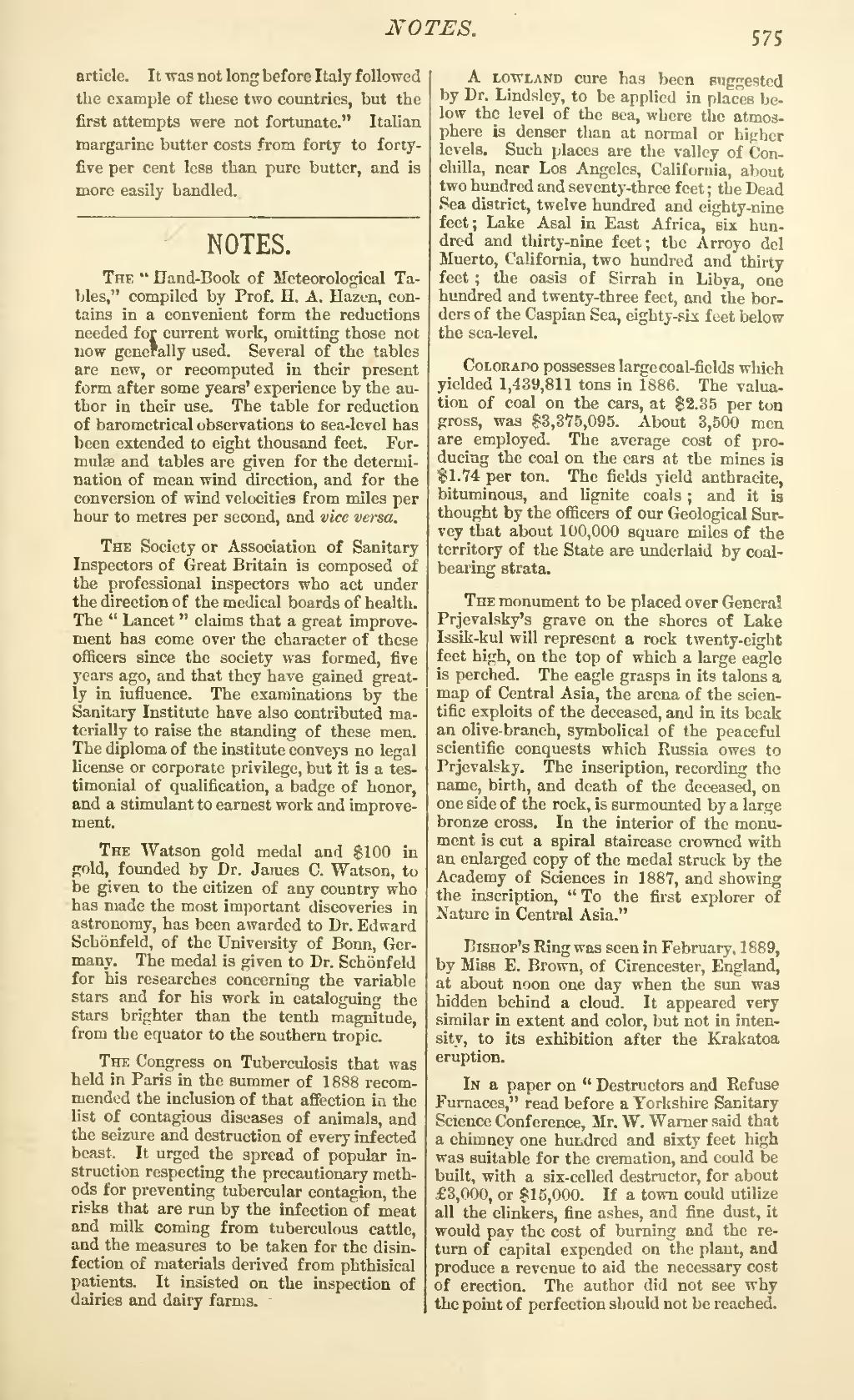article. It was not long before Italy followed the example of these two countries, but the first attempts were not fortunate." Italian margarine butter costs from forty to forty-five per cent less than pure butter, and is more easily handled.
The "Hand-Book of Meteorological Tables," compiled by Prof. H. A. Hazen, contains in a convenient form the reductions needed for current work, omitting those not now generally used. Several of the tables are new, or recomputed in their present form after some years' experience by the author in their use. The table for reduction of barometrical observations to sea-level has been extended to eight thousand feet. Formulæ and tables are given for the determination of mean wind direction, and for the conversion of wind velocities from miles per hour to metres per second, and vice versa.
The Society or Association of Sanitary Inspectors of Great Britain is composed of the professional inspectors who act under the direction of the medical boards of health. The "Lancet" claims that a great improvement has come over the character of these officers since the society was formed, five years ago, and that they have gained greatly in influence. The examinations by the Sanitary Institute have also contributed materially to raise the standing of these men. The diploma of the institute conveys no legal license or corporate privilege, but it is a testimonial of qualification, a badge of honor, and a stimulant to earnest work and improvement.
The Watson gold medal and $100 in gold, founded by Dr. James C. Watson, to be given to the citizen of any country who has made the most important discoveries in astronomy, has been awarded to Dr. Edward Schönfeld, of the University of Bonn, Germany, The medal is given to Dr. Schönfeld for his researches concerning the variable stars and for his work in cataloguing the stars brighter than the tenth magnitude, from the equator to the southern tropic.
The Congress on Tuberculosis that was held in Paris in the summer of 1888 recommended the inclusion of that affection in the list of contagious diseases of animals, and the seizure and destruction of every infected beast. It urged the spread of popular instruction respecting the precautionary methods for preventing tubercular contagion, the risks that are run by the infection of meat and milk coming from tuberculous cattle, and the measures to be taken for the disinfection of materials derived from phthisical patients. It insisted on the inspection of dairies and dairy farms.
A lowland cure has been suggested by Dr. Lindsley, to be applied in places below the level of the sea, where the atmosphere is denser than at normal or higher levels. Such places are the valley of Conchilla, near Los Angeles, California, about two hundred and seventy-three feet; the Dead Sea district, twelve hundred and eighty-nine feet; Lake Asal in East Africa, six hundred and thirty-nine feet; the Arroyo del Muerto, California, two hundred and thirty feet; the oasis of Sirrah in Libya, one hundred and twenty-three feet, and the borders of the Caspian Sea, eighty-six feet below the sea-level.
Colorado possesses large coal-fields which yielded 1,439,811 tons in 1886. The valuation of coal on the cars, at $2.35 per ton gross, was §3,375,095. About 3,500 men are employed. The average cost of producing the coal on the cars at the mines is $1.74 per ton. The fields yield anthracite, bituminous, and lignite coals; and it is thought by the officers of our Geological Survey that about 100,000 square miles of the territory of the State are underlaid by coal-bearing strata.
The monument to be placed over General Prjevalsky's grave on the shores of Lake Issik-kul will represent a rock twenty-eight feet high, on the top of which a large eagle is perched. The eagle grasps in its talons a map of Central Asia, the arena of the scientific exploits of the deceased, and in its beak an olive-branch, symbolical of the peaceful scientific conquests which Russia owes to Prjevalsky. The inscription, recording the name, birth, and death of the deceased, on one side of the rock, is surmounted by a large bronze cross. In the interior of the monument is cut a spiral staircase crowned with an enlarged copy of the medal struck by the Academy of Sciences in 1887, and showing the inscription, "To the first explorer of Nature in Central Asia."
Bishop's Ring was seen in February, 1889, by Miss E. Brown, of Cirencester, England, at about noon one day when the sun was hidden behind a cloud. It appeared very similar in extent and color, but not in intensity, to its exhibition after the Krakatoa eruption.
In a paper on "Destructors and Refuse Furnaces," read before a Yorkshire Sanitary Science Conference, Mr. W. Warner said that a chimney one hundred and sixty feet high was suitable for the cremation, and could be built, with a six-celled destructor, for about £3,000, or $15,000. If a town could utilize all the clinkers, fine ashes, and fine dust, it would pay the cost of burning and the return of capital expended on the plant, and produce a revenue to aid the necessary cost of erection. The author did not see why the point of perfection should not be reached.
